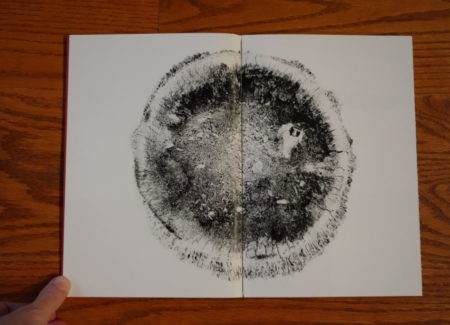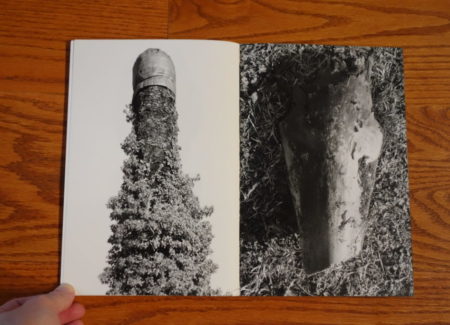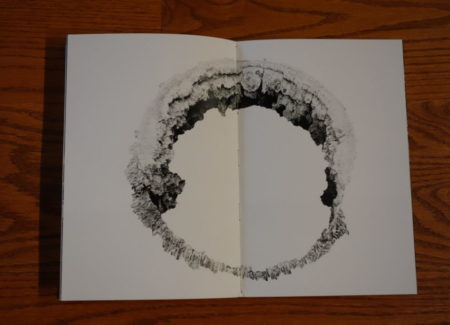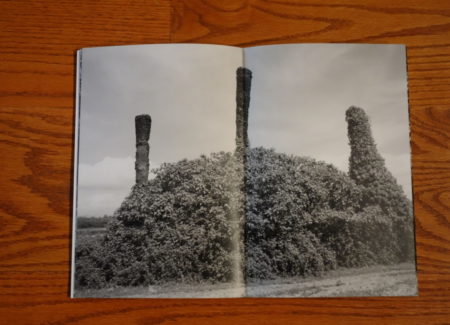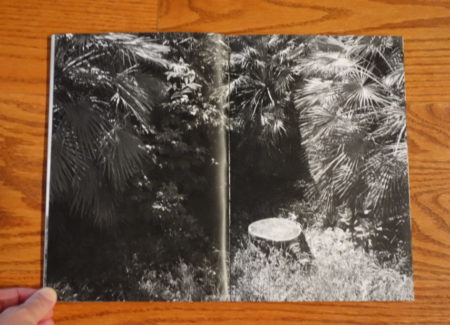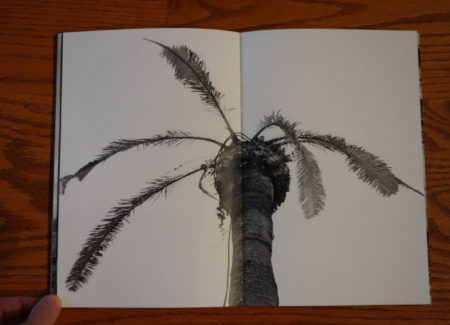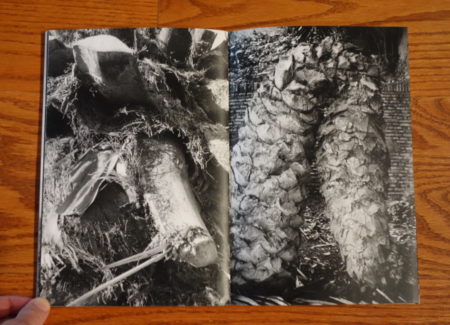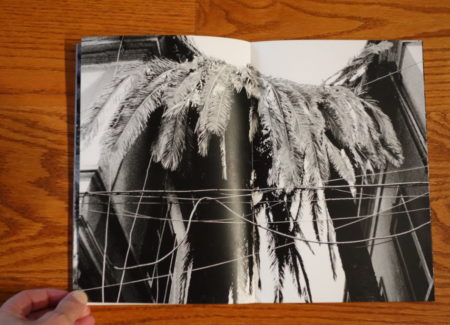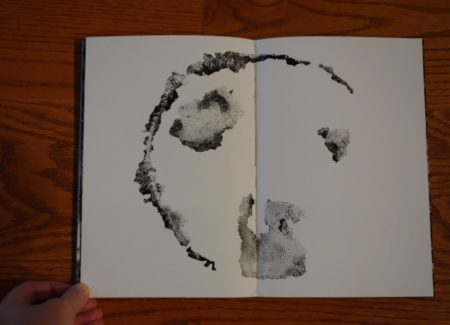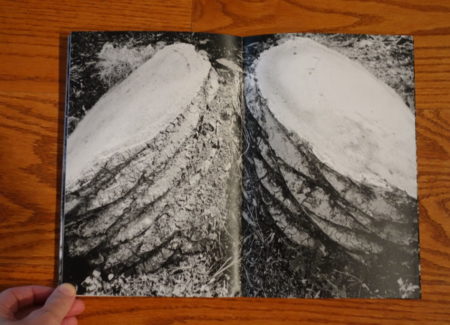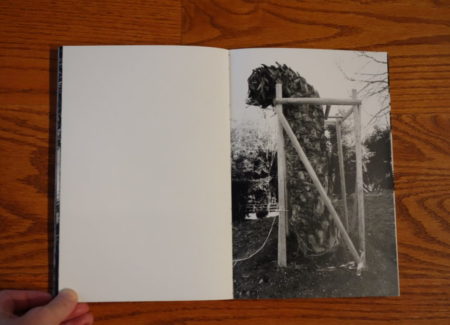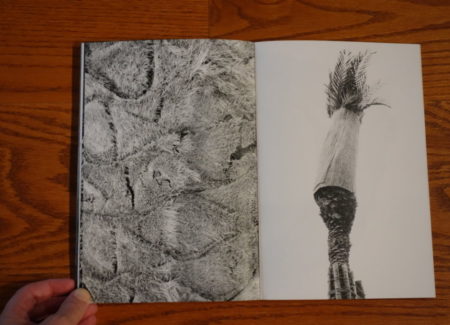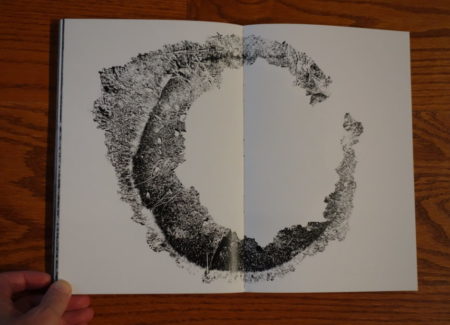JTF (just the facts): Self published in 2016 (here). Hardcover (Bodonian binding), 92 pages, with 57 black and white reproductions. Includes an annotated map of Rome, a flow chart of scientific information, and an essay by Antimo Palumbo. In an edition of 55. (Cover and spread shots below.)
Comments/Context: Back in 1971, Ed Ruscha self published a small artist’s book entitled A Few Palm Trees. In this diminutive volume, he took a concise look at the ubiquitous palm trees of Los Angeles, isolating them against white backgrounds and creating a taxonomy of formal studies. Like his other collections of local gas stations, swimming pools, and apartment buildings, the iconic palm trees were indelibly part of the sprawling suburban landscape, giving Los Angeles its own unique visual flavor. When examined carefully, his largely healthy specimens had their own signature silhouettes and natural features, but seen together, they seemed to conceptually represent life in sunny California.
But for the Italian photographer Flaminia Celata, palm trees don’t make her think of Los Angeles, they symbolize the grand city of Rome. The problem is that the majestic Roman palm trees that dot the historic city are being swiftly killed off, the victim of the invasive red palm weevil (Rynchophorus ferrugineus). Her self-published photobook, Olivier, named after the 18th century French naturalist/entomologist who discovered the bug, chronicles the current state of Roman palm trees, and it’s a not happy story.
In tackling her subject, Celata expands on Ruscha’s isolating approach, adding a handful of additional visual strategies to the mix. When she does employ the washed out white background effect, she limits it to forms that are particularly striking and provocative – trunks that are jagged and rotten, canopies that are shorn of their fronds, trees that have been wrapped to protect them from infestation, and various other examples of the diseased, the afflicted, and the amputated. One extended foldout stresses how odd a palm tree looks without its broad leaves, its form a single ungainly vertical line. And another image documents a forlorn palm with just a single remaining frond, a despairing fate akin to the humble Charlie Brown Christmas tree.
Celata’s up close photographs are dominated by all over texture. She shows us fronds eaten away until they are spotted with dark stringy holes, fronds decayed until they seem to unravel like cloth or flake away like peeling paint, trunks hollowed out and filled with rotted dust, and roughly cut crowns with endless rows marred by chopping. Fronds crack and split, break down into fluffy tendrils, and disintegrate into the surrounding grass, each image simultaneously a piece of evidence of the relentless destruction process and an artistic study in the tactile nuances of crisp mid range greys.
Circular cross section images of infested trunks abstract the problem with visual intelligence. Full trunks waste away to open circles, the damage incrementally replaced with blank whiteness, turning the images into elemental Rorschach tests or discouraging brain scans. Many of the tress are reduced to just a few spots of recognizable wood, and when Celata superimposes red dots on the circular map of Rome where palms have either died or been infected, this echo of destruction seems ready to hollow out Rome itself.
Other images capture the stunted and decaying palms in situ – dying in front of palatial architecture, drooping in sweeping parklands, drowning in choking ivy, and hemmed in by city buildings, wire fencing, and electrical wires. And when these humiliations finally come to an end, what’s left is a flat stump where something of enduring beauty once stood, inserting an abrupt vacancy in the landscape.
What’s smart about Celata’s photobook is that it balances its urgent message with a nuanced artistic perspective – she has taken a layered approach to telling the photographic story of the disappearing palms, and that integrated package is part visual polemic and part valentine to a lost lover. We intimately feel her sense of frustration at something meaningful slipping away right before our eyes (almost a modern climate-centric parallel to the fiddling while Rome burns story from antiquity), but she resorts to neither hectoring nor nostalgia to make her case. In the end, her photobook leaves us with an ominous sense of dispiriting incremental tragedy, the glory of the once towering palms slowly being reduced to dust.
Collector’s POV: Flaminia Celata does not appear to have gallery representation at this time. As a result, interested collectors should likely connect with her directly via her website (linked in the sidebar).

